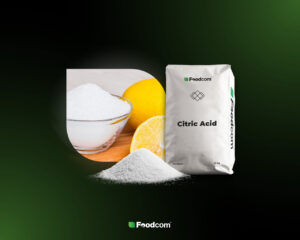- Caratteristiche e origine: l’acido citrico (E330) è un composto chimico naturale presente nella frutta e utilizzato anche in forma sintetica.
- Proprietà: abbassa il pH, prolunga la durata di conservazione dei prodotti, ha proprietà sbiancanti ed esfolianti.
- Usi: viene utilizzato nell’industria alimentare, cosmetica e farmaceutica, come detergente e conservante per mangimi.
- Sicurezza: l’acido citrico è sicuro in quantità moderate, ma un uso eccessivo può provocare irritazioni.
Che cos’è l’acido citrico?
L‘acido citrico (E330), noto anche come acido citrico, è un composto chimico organico, classificato come AHA, o alfa-idrossiacido. La formula dell’acido citrico è C₆H₈O₇. È presente in natura non solo nei limoni, come potrebbe suggerire il nome, ma in generale in frutti come arance, ribes nero, fragole o ananas. L’acido si trova anche nella maggior parte degli organismi: è un importante prodotto intermedio del ciclo di Krebs (noto anche come ciclo dell’acido citrico), dove svolge un’importante funzione durante il processo di combustione dei carboidrati.
Può anche essere prodotto chimicamente, principalmente attraverso la fermentazione citrica, utilizzando enzimi e ceppi di batteri, più comunemente l ‘Aspergillus niger.
Proprietà dell’acido citrico
Acido Citrico si presenta sotto forma di cristalli bianchi e inodori. Tuttavia, ha un sapore aspro piuttosto pronunciato.
Ha una serie di proprietà utili. In primo luogo, quando viene aggiunto ai prodotti, ne abbassa il pH. Questa acidificazione fa sì che gli articoli durino più a lungo. Un pH più basso rende anche più stabili e meglio assorbiti le vitamine, i micronutrienti o gli antiossidanti contenuti negli alimenti. L’acido derivato dagli agrumi, ovviamente, ha anche l’effetto di rendere i prodotti più acidi.
Contribuisce a mantenere il colore originale dei prodotti, ad esempio di frutta e verdura. Ha anche un effetto sbiancante.
L’acido citrico è considerato una sostanza sicura. Se consumato con moderazione, non provoca effetti collaterali dannosi.
Usi dell’acido citrico
Viene utilizzato in molti settori industriali. Per le sue proprietà – effetto sul pH, sul gusto, sul colore e sulla durata di conservazione dei prodotti – è più comunemente utilizzato nell’industria alimentare.
L‘acido citrico è utilizzato anchein cosmetica , grazie alle sue proprietà esfolianti, schiarenti e regolatrici del pH, che contribuiscono a migliorare le condizioni della pelle, a ridurre la comparsa di imperfezioni e a promuovere l’idratazione cutanea. Inoltre, viene utilizzato nella produzione di prodotti per la pulizia e nell’industria farmaceutica come additivo per i farmaci, dove agisce come sostanza tampone, sostenendone l’efficacia.
Inoltre, l’acido citrico è entrato a far parte dei mangimi per animali : ha un effetto conservante sugli alimenti e migliora l’assorbimento del fosforo e il sapore dei mangimi, che a sua volta ne aumenta l’assunzione.
L’acido citrico negli alimenti
È un additivo alimentare che compare come E330 sulle etichette. È eccellente per prolungare la durata di conservazione dei prodotti e contribuire a preservarne il colore. Naturalmente, fa sì che gli alimenti mantengano la giusta acidità ed è un ottimo conservante. Inoltre, ha proprietà leganti e addensanti, per cui viene aggiunto a salse, marmellate o gelatine.
L’acido citrico viene utilizzato anche nell’industria dolciaria e della panificazione, aggiunto al bicarbonato di sodio come agente lievitante per le torte. Come acidificante, è anche un ingrediente importante nella produzione di formaggio, birra o vino.
L’acido citrico non compare solo come ingrediente nell’alimentazione umana, ma anche in quella animale. L’integrazione con questo ingrediente ha mostrato effetti positivi sul miglioramento delle prestazioni e della mineralizzazione ossea nei polli da carne e sulla crescita dei suinetti svezzati. Grazie all’aggiunta di acido citrico, il mangime non solo si mantiene fresco più a lungo, ma è anche più gustoso, aumentando così il consumo e il peso degli animali.
L’acido citrico nei cosmetici
La proprietà più popolare dell’acido citrico utilizzato nei cosmetici è la sua capacità di sbiancare l’epidermide. Per questo motivo si trova come ingrediente in prodotti per persone con discromie e tono della pelle non uniforme.
L’acido citrico esplica i suoi effetti sulla pelle anche nella prevenzione dell’invecchiamento, aiutando a distendere le rughe: influisce sul numero di glicosaminoglicani contenuti nella pelle, la cui funzione è quella di riempire gli spazi intercellulari. Questo mantiene la pelle idratata e compatta.
Ha anche un delicato effetto esfoliante, motivo per cui compare come ingrediente negli scrub, potenziando l’azione degli altri acidi utilizzati. Può essere utilizzato nei prodotti per la cura dei capelli: l’abbassamento del pH rende i capelli meno statici, più lucidi e più lisci.
L’acido citrico nell’industria farmaceutica
L’acido citrico è ampiamente utilizzato nell’industria farmaceutica, dove viene impiegato principalmente come sostanza tampone e stabilizzante e come regolatore di acidità. Grazie alle sue proprietà di regolazione del pH, viene utilizzato in varie formulazioni di farmaci come preparazioni orali, colliri e soluzioni iniettabili per mantenerne la stabilità chimica e aumentare la biodisponibilità dei principi attivi. Inoltre, l’acido citrico agisce come conservante, proteggendo i prodotti farmaceutici dalla crescita microbica e prolungandone la durata di conservazione. La sua capacità di legare gli ioni metallici, grazie alle sue proprietà chelanti, impedisce a questi ioni di influire negativamente sui principi attivi dei farmaci. In questo modo, l’acido citrico favorisce l’efficacia e la durata di molti preparati medici, rendendoli più sicuri ed efficaci.
L’acido citrico come disincrostante e detergente
Oltre a essere un ingrediente di cosmetici e alimenti, l’acido citrico è anche un popolare agente di pulizia utilizzato in ogni casa. In polvere, è ideale per pulire varie superfici e per disincrostare bollitori e altri elettrodomestici. Per decalcificare in modo efficace, è sufficiente aggiungere qualche cucchiaino di acido citrico, versare dell’acqua e poi far bollire l’acqua nel bollitore: questo processo provoca lo scioglimento delle incrostazioni, lasciando l’apparecchio pulito e pronto per un ulteriore utilizzo. Può essere utilizzato anche per disincrostare le stoviglie e come ingrediente di prodotti per la pulizia. Grazie alla sua versatile azione pulente e disincrostante, è apprezzato in ogni casa, sia per mantenere pulite le stoviglie che per rimuovere efficacemente i depositi.
Nocività dell’acido citrico
L’acido è riconosciuto come una sostanza sicura per l’uso nell’industria alimentare, cosmetica e farmaceutica, a condizione che sia utilizzato in quantità moderate. Tuttavia, un uso eccessivo può causare alcuni problemi di salute, come l’irritazione delle membrane mucose, soprattutto nelle persone sensibili. Se viene a contatto con gli occhi, l’acido può causare bruciore e arrossamento. L’ingestione di una quantità eccessiva di E330 può portare all’irritazione del tratto gastrointestinale, causando dolori o disturbi addominali. Nelle persone con la pelle sensibile, l’acido citrico in alte concentrazioni può causare irritazioni, quindi è opportuno usare cautela quando si utilizzano cosmetici con il suo contenuto, soprattutto se la pelle è soggetta ad allergie o danni.
Il nostro team di supporto alle vendite assiste i nostri partner commerciali nella conduzione delle transazioni commerciali in modo efficiente ed efficace, per garantire la massima qualità del servizio a tutti i nostri partner commerciali. Il nostro team di logistica si occuperà del trasporto e il nostro dipartimento finanziario sarà responsabile di tutte le questioni relative alla parte finanziaria della transazione.










